Easy Tomato Pudding Recipe
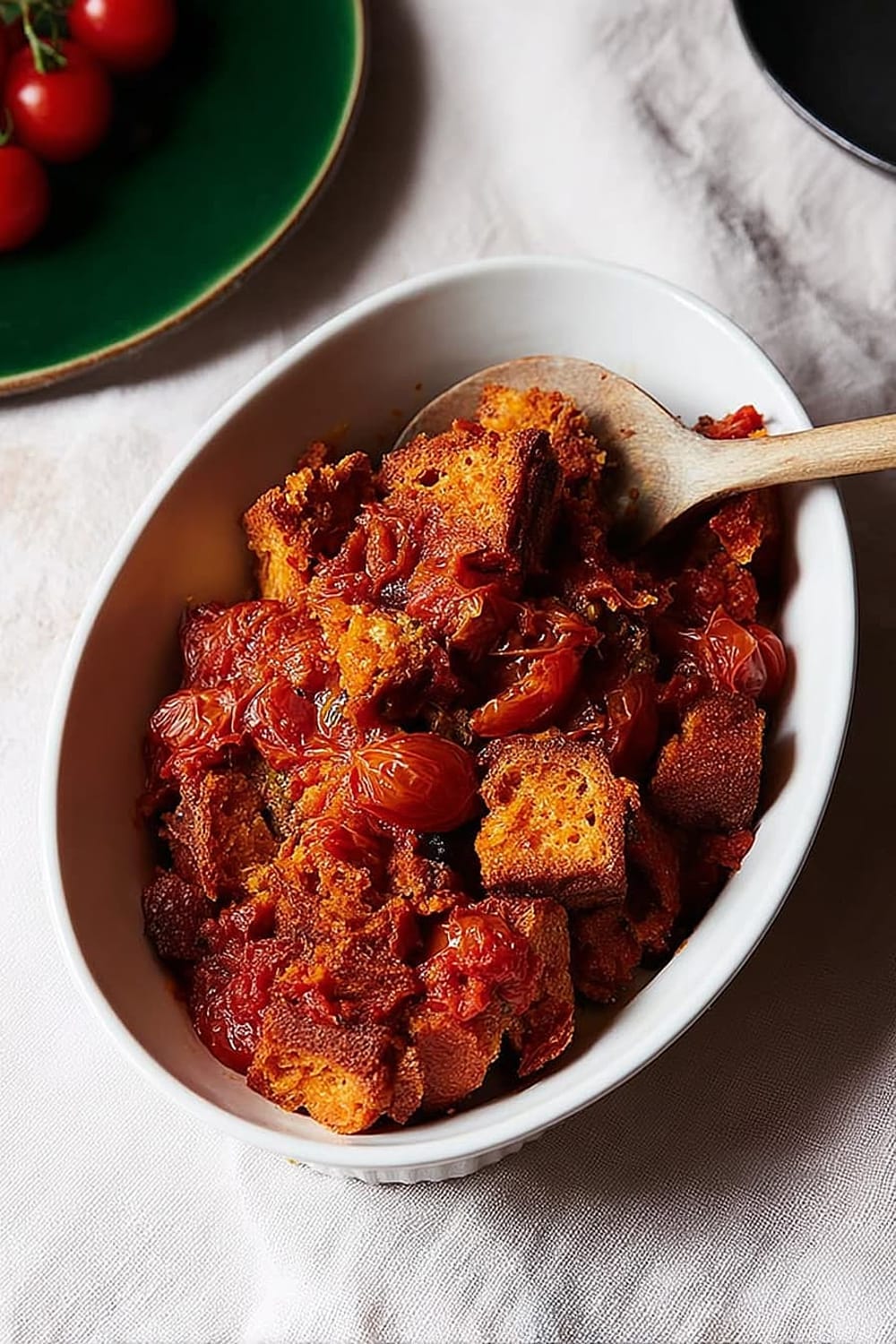
This tomato pudding is about to become your secret weapon for impressing dinner guests without breaking a sweat – it’s basically comfort food masquerading as something fancy.
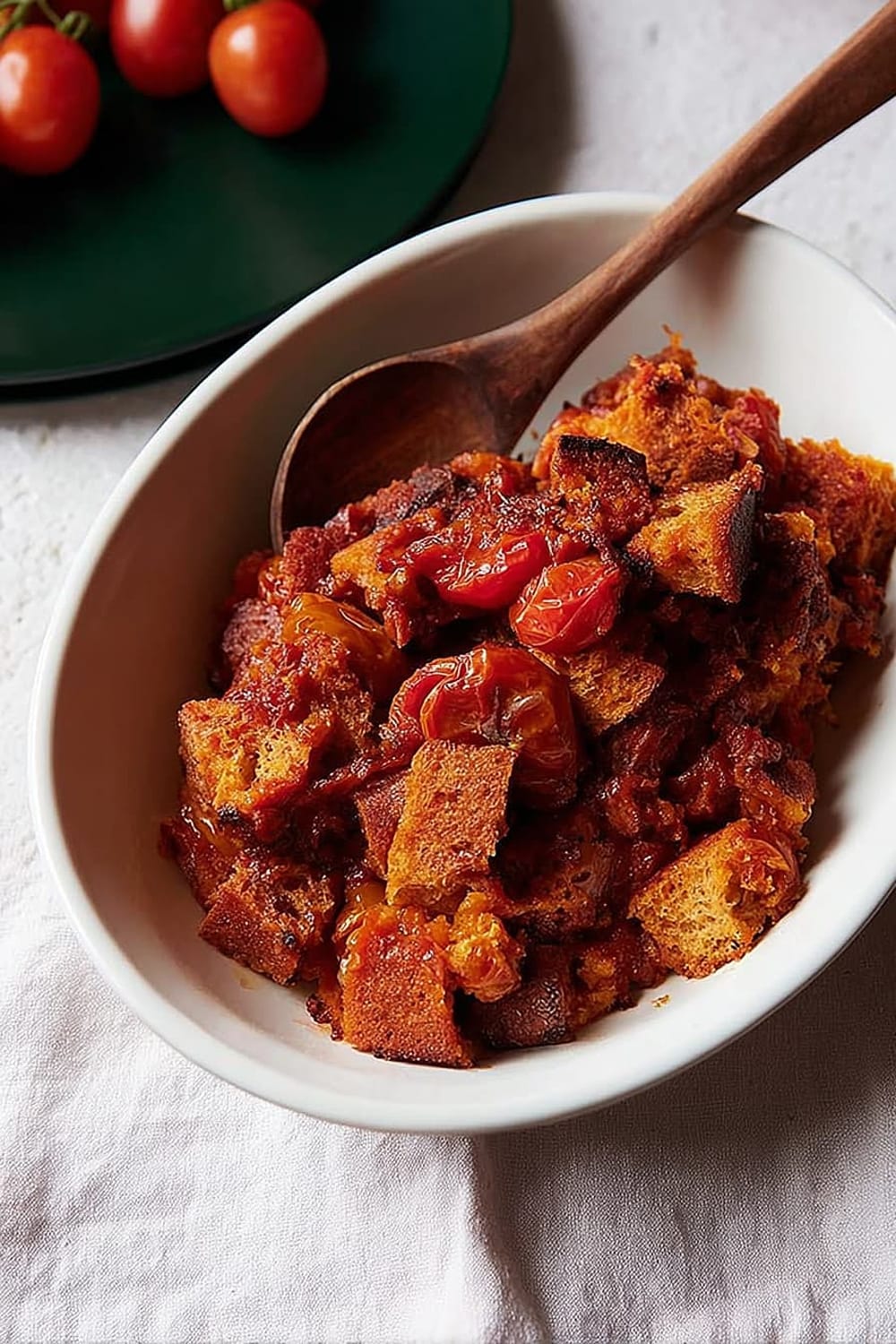
Picture this: caramelized edges that crackle slightly when you cut into them, revealing a soft, savory-sweet interior that tastes like childhood memories wrapped in grown-up sophistication.
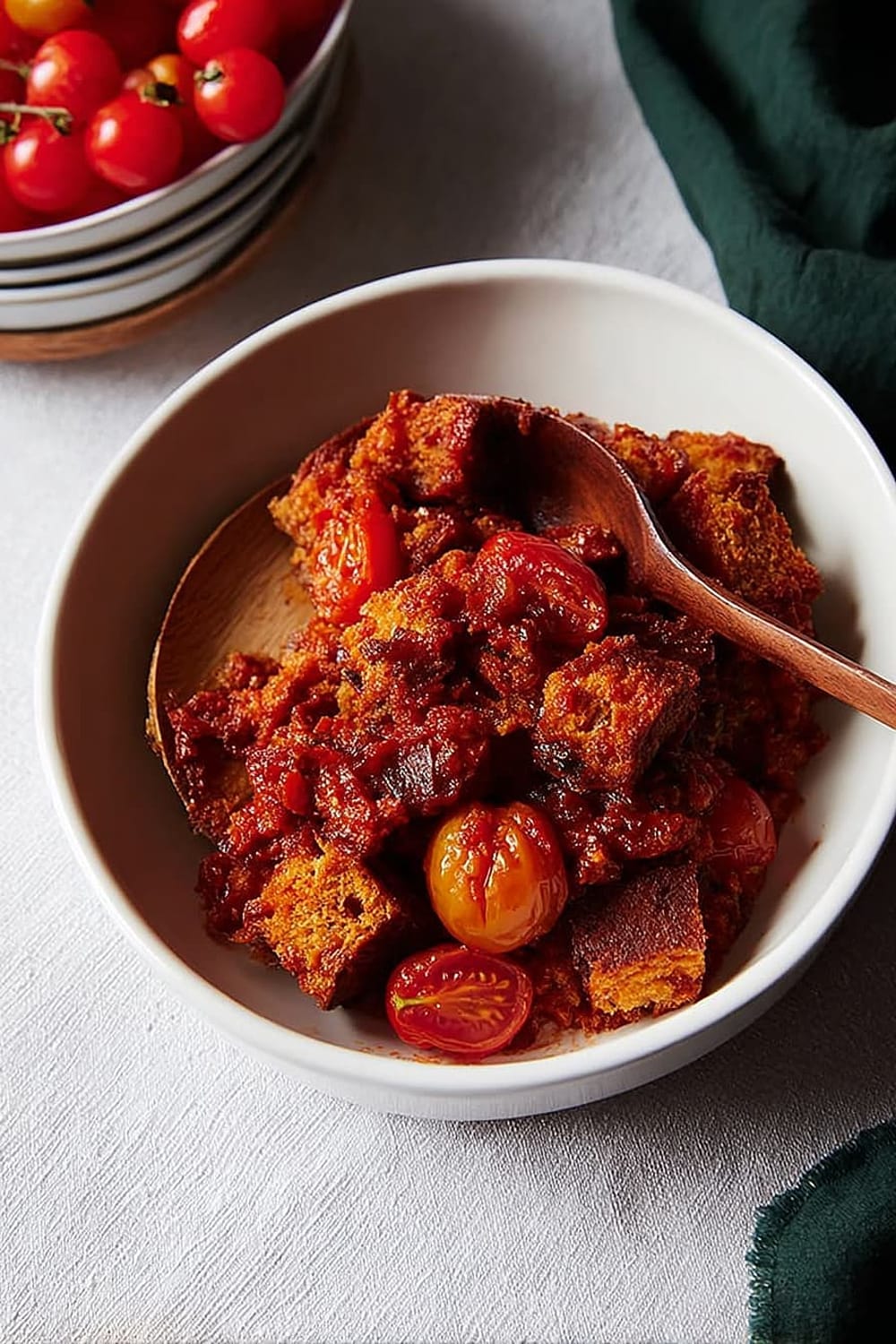
The combination of buttery bread cubes soaking up that glossy tomato-brown sugar mixture creates the most incredible contrast of textures – crispy on top, pudding-soft underneath.
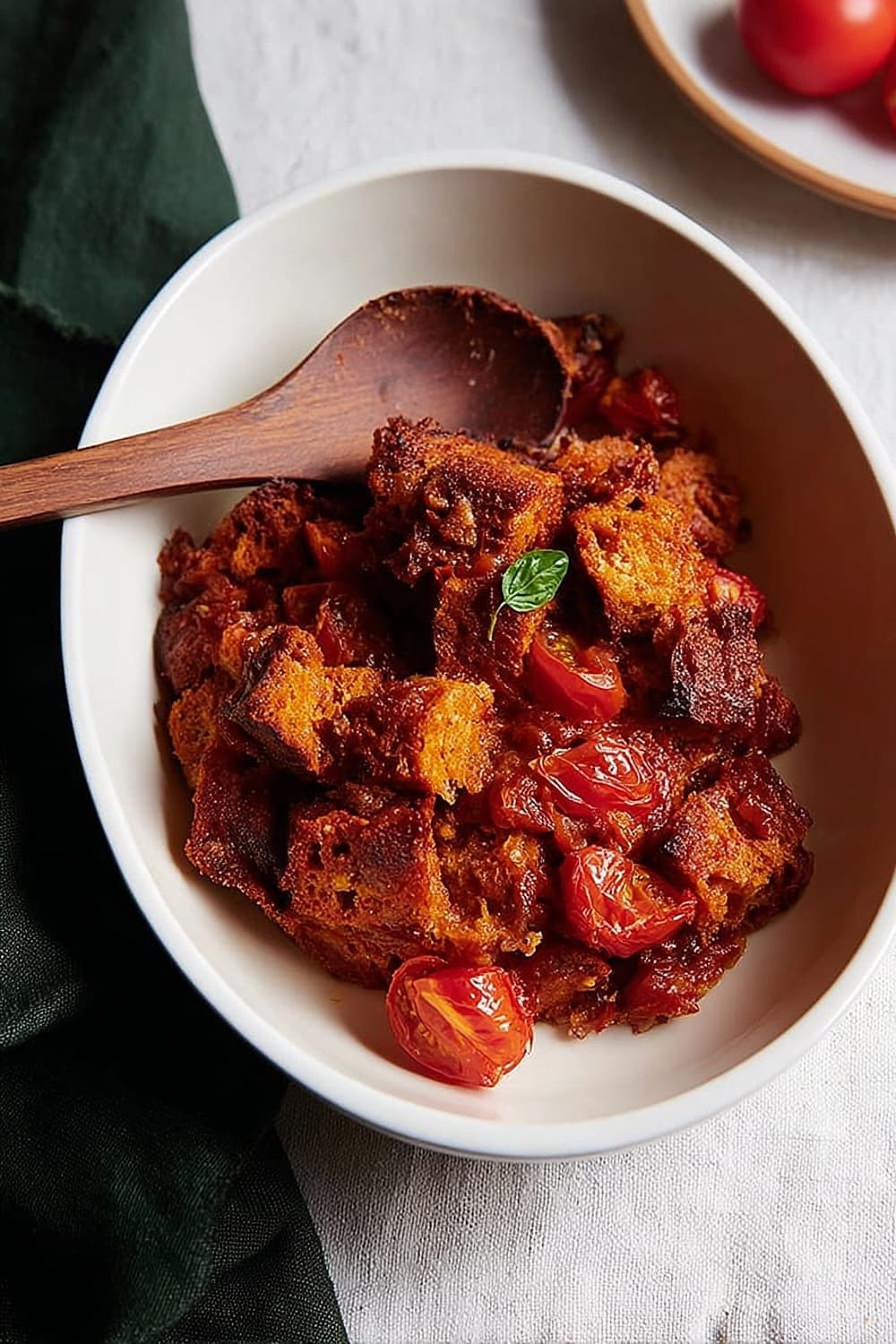
What makes this recipe absolutely genius is how it transforms simple pantry staples into something that looks like you spent hours in the kitchen when you really just tossed everything together.
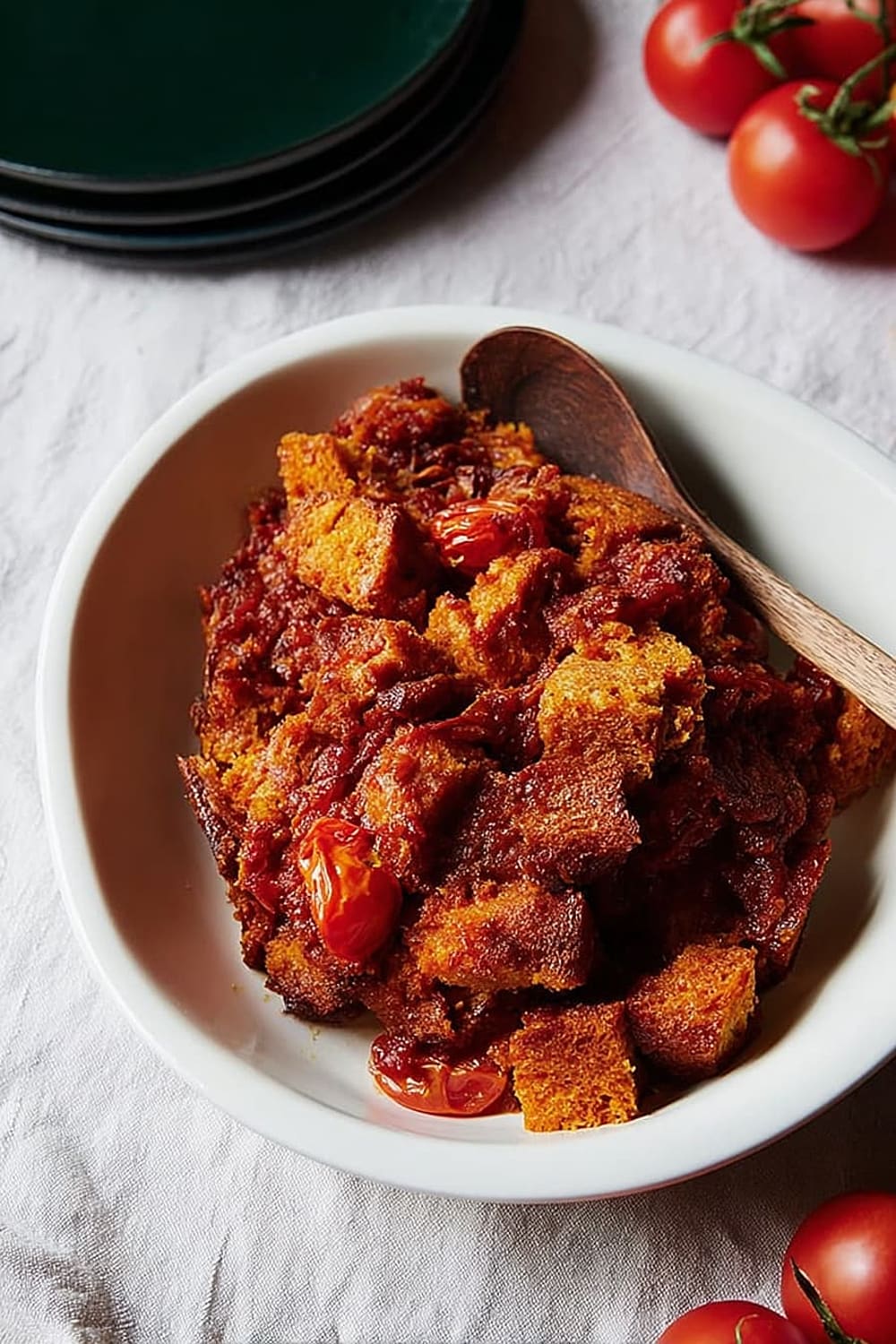
The candied ginger adds this unexpected pop of warmth that elevates the whole dish from “weird but good” to “wait, can you make this again next week?”
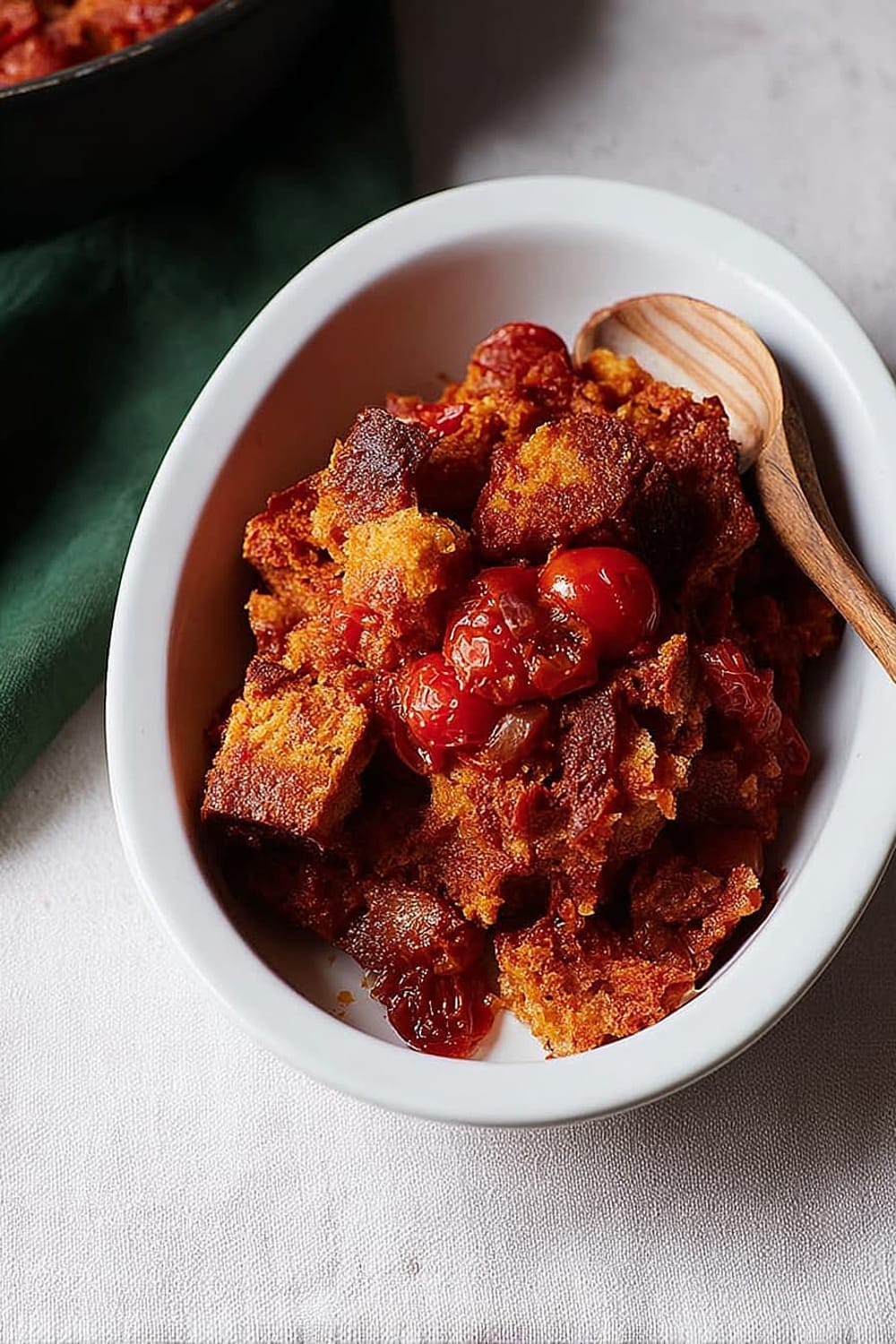
Fair warning: people are going to ask for the recipe, and when you tell them it’s basically bread and tomato sauce, they’re not going to believe you until they make it themselves.
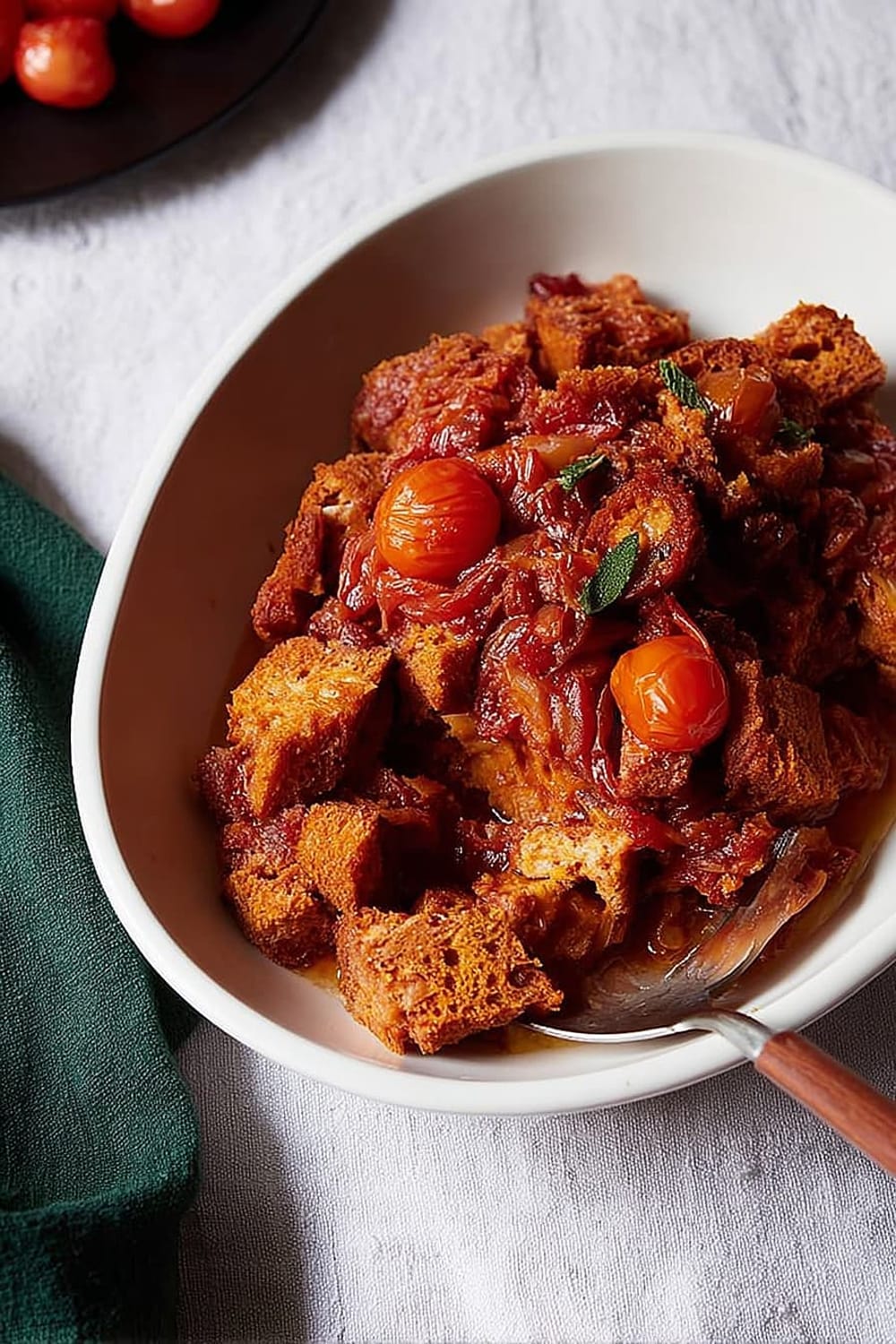
Ingredients
For the bread base
- 6 cups white bread (about 6-8 thick slices), cut into 1-inch cubes, crusts removed – day-old sourdough works beautifully, but soft white grocery store bread is perfect too
- ½ cup butter, melted
For the tomato mixture
- 1 cup tomato puree – look for high-quality, organic varieties for the best flavor
- 1 cup brown sugar – dark brown preferred for deeper molasses notes, though light brown works well
- ¼ cup fresh squeezed orange juice – the acidity balances the sweetness perfectly
- ¼ teaspoon candied ginger, minced fine
- ¼ cup boiling water
- ½ teaspoon salt – use sea salt or kosher salt for best results
Instructions
Preparation
- 1 Preheat your oven to 350°F (175°C) and position the rack in the center. This temperature ensures even cooking without burning the delicate top layer.
- 2 Cut the bread into thick slices if you haven’t already, then carefully remove all crusts using a sharp serrated knife. You want 5-6 cups total of bread cubes. Pro tip: if you prefer a firmer pudding, use the full 6 cups; for a softer, more custard-like texture, stick closer to 5 cups.
Prepare the bread base
- 3 In a medium mixing bowl, toss the bread cubes with the ½ cup melted butter, using a large spoon or your hands to ensure every piece is well-coated. The butter should soak into the bread slightly but still leave a glossy coating.
- 4 Brush any remaining melted butter inside your 8×8-inch baking dish or similar-sized casserole dish, then add the buttered bread cubes. Space them evenly across the bottom – they don’t need to be in a single layer, but try to distribute them uniformly.
Make the tomato sauce
- 5 In a small saucepan, combine the 1 cup tomato puree, 1 cup brown sugar, ¼ cup fresh orange juice, ¼ teaspoon minced candied ginger, ¼ cup boiling water, and ½ teaspoon salt. The mixture will look quite thick at first.
- 6 Bring the mixture to a gentle simmer over medium heat, stirring frequently to prevent sticking. Cook for 5 minutes until it thickens slightly and the sugar completely dissolves. The sauce should coat the back of a spoon but still pour easily.
Assemble and bake
- 7 Pour the hot tomato mixture evenly over the prepared bread cubes. Using a fork or wooden spoon, gently press the sauce down into the bread, ensuring every piece is completely coated and saturated. The liquid should just barely cover the bread.
- 8 Bake uncovered for 45-50 minutes until the edges are deeply caramelized and golden-brown, and the center puffs up slightly. If the top begins to get too dark before the center is set, loosely cover with aluminum foil for the remaining cooking time.
Recommended Equipment and Kitchen Tools
Essential Tools (for best results)
- Medium saucepan – A heavy-bottomed pan prevents the sugar mixture from scorching and ensures even heating throughout the cooking process
- 8×8-inch baking dish – Glass or ceramic works beautifully for even heat distribution, though a cast iron skillet creates amazing caramelized edges
- Sharp serrated knife – Makes removing bread crusts and cutting uniform cubes much easier than a regular chef’s knife
- Large mixing bowl – Gives you plenty of room to toss the bread with butter without making a mess
Helpful Upgrades
- Kitchen scale – For perfectly consistent results, weigh your bread cubes rather than measuring by volume
- Silicone spatula – Ideal for scraping every bit of that precious tomato mixture from the saucepan
- Instant-read thermometer – The center should reach about 160°F (71°C) when fully set
Nice-to-Have Options
- Bench scraper – Makes transferring chopped bread cubes from cutting board to bowl effortless
- Parchment paper – Line your baking dish for easier cleanup, though it’s not necessary for this recipe
Recipe Variations and Dietary Modifications
Gluten-Free Adaptation
- Replace regular bread with 6 cups gluten-free bread cubes – choose a sturdy variety that won’t completely fall apart when soaked
- Add 1 tablespoon cornstarch to the tomato mixture for extra binding power
- Expect a slightly denser texture, but the flavors remain just as delicious
Dairy-Free Modifications
- Substitute the butter with ½ cup olive oil or vegan butter – olive oil adds a lovely Mediterranean note
- Brush the baking dish with additional oil instead of butter
Vegan Version
- Use the dairy-free modifications above
- Ensure your bread is vegan (many contain milk or eggs)
- The rest of the ingredients are naturally plant-based
Flavor Variations
- Herb-infused version: Add 1 teaspoon dried thyme or 2 tablespoons fresh basil to the tomato mixture
- Spicy kick: Include ¼ teaspoon red pepper flakes with the candied ginger
- Savory depth: Stir in 2 tablespoons Worcestershire sauce to the tomato base
- Holiday twist: Replace candied ginger with ½ teaspoon ground cinnamon and ¼ teaspoon nutmeg
Nutritional Information and Health Benefits
Key Nutritional Highlights
This comfort food classic provides approximately 285 calories per serving when divided into 8 portions. Each serving contains about 45 grams carbohydrates, 8 grams fat, and 4 grams protein. The dish offers 3 grams of fiber from the bread and tomatoes, plus significant amounts of vitamin C from the tomato puree and fresh orange juice.
Health Benefits of Main Ingredients
The tomato puree delivers lycopene, a powerful antioxidant that becomes more bioavailable when tomatoes are cooked and processed. This compound supports heart health and may have protective effects against certain cancers. The orange juice contributes vitamin C and natural citrus bioflavonoids that enhance iron absorption from other foods. Candied ginger provides gingerol compounds known for their anti-inflammatory properties and digestive benefits. Even the brown sugar offers trace minerals like calcium and potassium that refined white sugar lacks.
Dietary Considerations
This recipe contains gluten from wheat bread and is vegetarian but not vegan due to the butter. It’s naturally nut-free and egg-free. One serving provides about 30% of daily vitamin C needs and makes an excellent source of complex carbohydrates for sustained energy.
Smart Swaps and Ingredient Substitutions
Common Substitutions:
- Tomato puree → 1 cup tomato sauce (reduce salt by half) or ¾ cup tomato paste mixed with ¼ cup water
- Brown sugar → 1 cup coconut sugar or ¾ cup maple syrup (reduce liquid by 2 tablespoons)
- Fresh orange juice → 2 tablespoons apple cider vinegar plus 2 tablespoons water for acidity
- Candied ginger → ½ teaspoon ground ginger or 1 teaspoon fresh grated ginger
Budget-Friendly Swaps:
- Day-old sourdough → Regular sandwich bread or French bread from the bakery markdown section
- Organic tomato puree → Store-brand tomato puree (the cooking process equalizes most flavor differences)
- Fresh orange juice → Bottled orange juice (not from concentrate works best)
Pantry Emergency Substitutions:
- Candied ginger → Ground ginger plus 1 teaspoon honey mixed into the sauce
- Brown sugar → White sugar plus 2 tablespoons molasses
- Butter → Neutral oil like vegetable or canola oil
Pro Tips for Substitutions:
- Store leftover tomato puree in ice cube trays for future recipes
- When using maple syrup instead of brown sugar, reduce oven temperature by 25°F to prevent over-browning
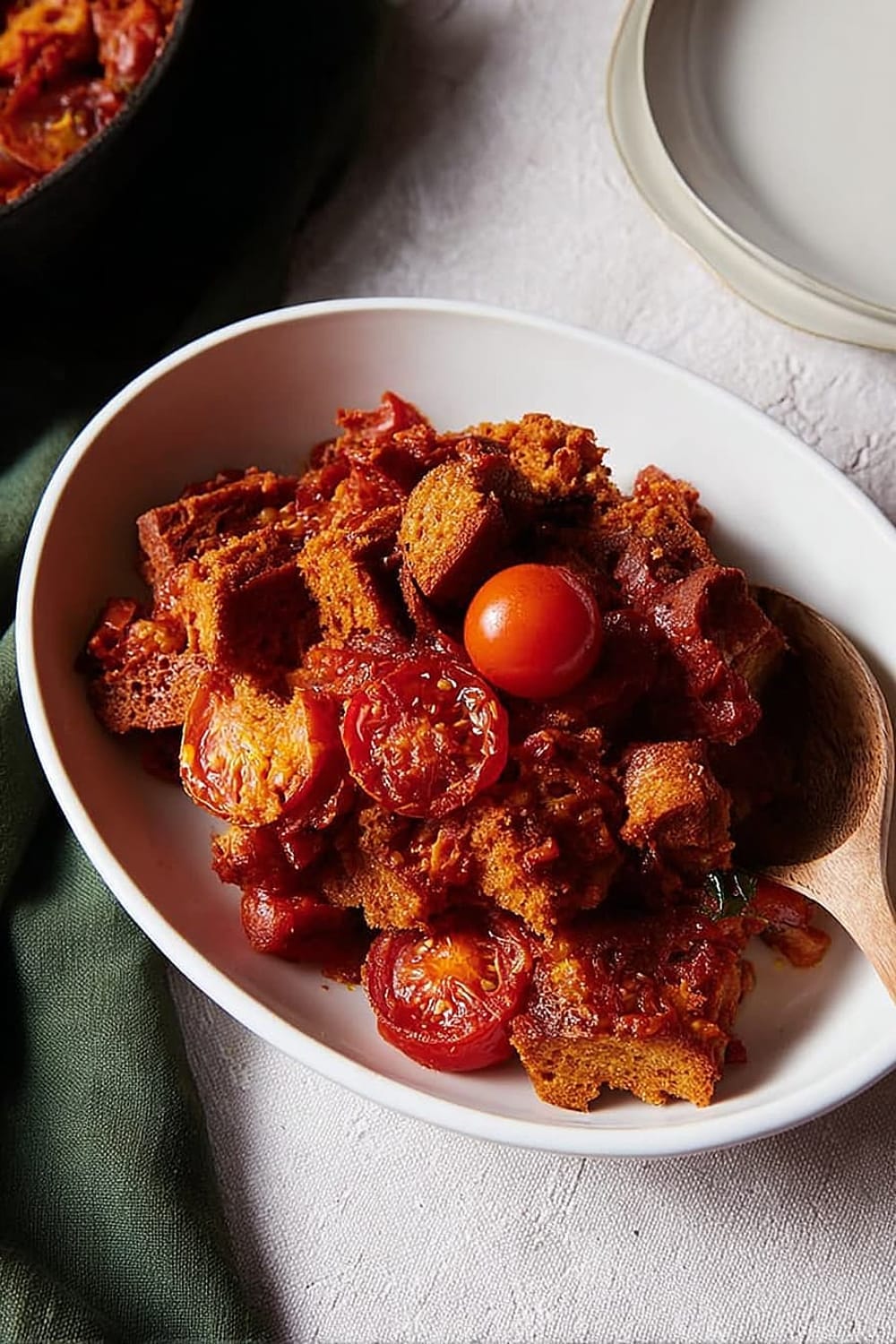
Make It Diabetes-Friendly
Sugar Substitutions:
- Replace the 1 cup brown sugar with ½ cup erythritol or ⅓ cup stevia blend designed for baking
- Use sugar-free brown sugar substitute at a 1:1 ratio for familiar flavor
- Monk fruit sweetener works excellently – use ⅓ cup to replace the full cup of brown sugar
Carb Modifications:
- Substitute 2 cups of the bread with cauliflower florets blanched for 3 minutes in boiling water
- Use low-carb bread and reduce total amount to 4 cups instead of 6
- Try almond flour bread or coconut flour bread for significant carb reduction
Portion & Timing Tips:
- Cut into 12 smaller servings instead of 8 for better portion control
- Estimated 18-22 grams carbs per smaller serving with sugar substitutes
- Pair with grilled chicken or roasted vegetables to balance blood sugar response
- Serve as a side dish rather than main course to minimize carb impact
Total Carb Reduction: These modifications can reduce carbs by approximately 40-50% compared to the original recipe.
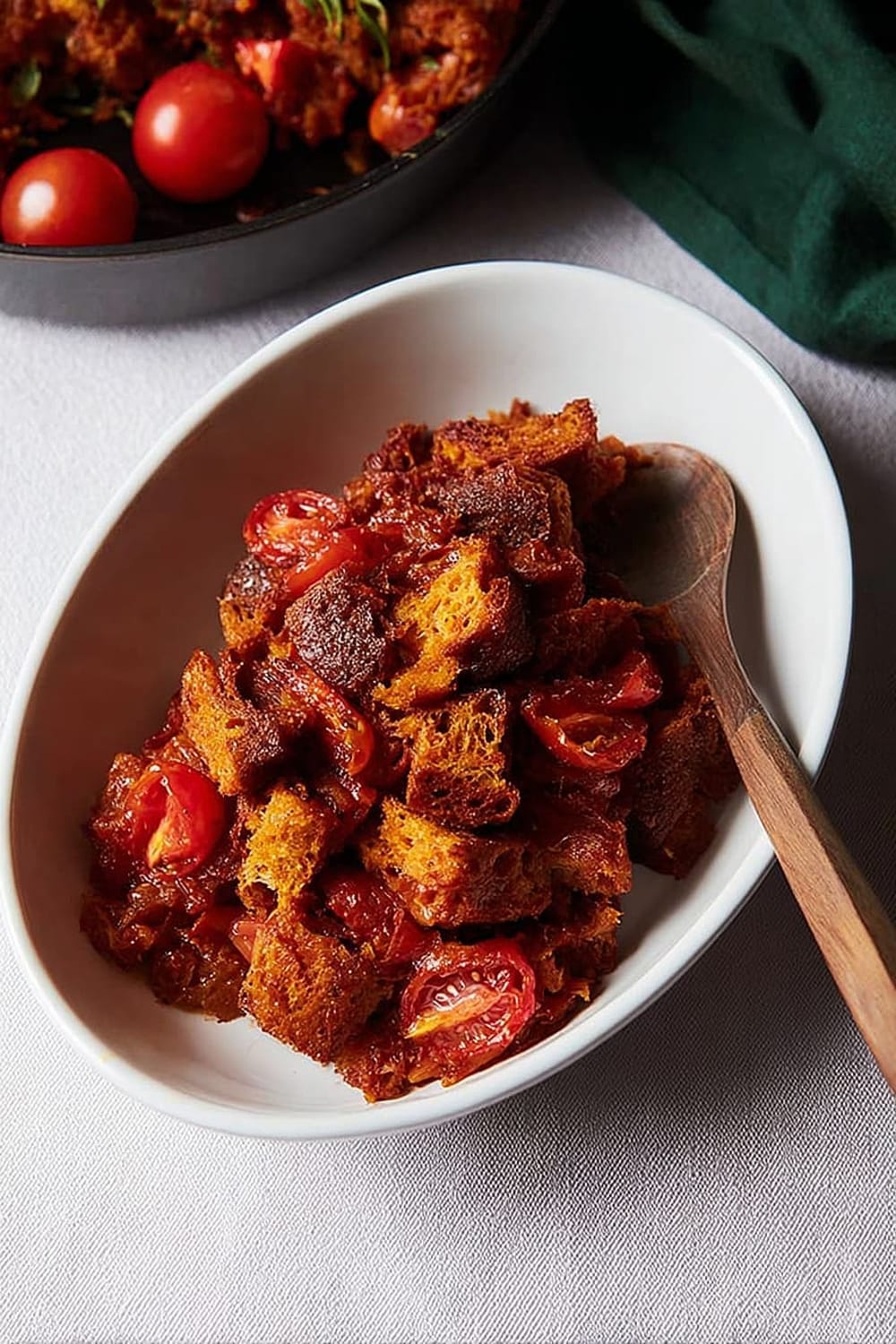
Perfect Pairing Suggestions
Beverage Pairings
A medium-bodied red wine like Merlot or Zinfandel complements the sweet-savory profile beautifully, while hard cider echoes the fruit notes from the orange juice. For non-alcoholic options, sparkling apple juice or ginger beer enhance the warm spices, and black tea with a touch of honey creates a cozy autumn pairing.
Side Dish Recommendations
This tomato pudding shines alongside roasted pork tenderloin or herb-crusted chicken thighs where the savory-sweet profile complements rich proteins. Steamed green beans with almonds provide a fresh contrast, while roasted Brussels sprouts with bacon add textural variety. Wild rice pilaf or garlic mashed potatoes round out the comfort food theme perfectly.
Complete Meal Ideas
Build a harvest dinner around this pudding with roasted turkey, cranberry sauce, and roasted root vegetables. For casual entertaining, pair it with grilled sausages, coleslaw, and corn on the cob for an elevated barbecue spread. The pudding also works beautifully in a brunch buffet alongside scrambled eggs, bacon, and fresh fruit.
Occasion Suggestions
This recipe is perfect for Thanksgiving as a unique alternative to traditional sides, potluck dinners where it travels well, and Sunday family meals when you want something special but not complicated. The make-ahead friendly nature makes it ideal for holiday entertaining and meal prep situations.
Pro Tips and Troubleshooting
Professional Techniques
Let the bread cubes sit with the butter for 5-10 minutes before adding the tomato mixture – this allows better absorption and prevents soggy spots. Toast the bread cubes lightly in a 300°F oven for 8-10 minutes before buttering for extra texture contrast. Always simmer the tomato mixture until it coats a spoon; thin sauce creates a watery final dish.
Common Mistake Prevention
Don’t skip removing the crusts – they create tough, chewy bits that disrupt the smooth texture. Press the tomato mixture into the bread thoroughly; surface-sitting sauce won’t penetrate properly. Cover with foil if the top browns too quickly, but remove it for the last 10 minutes to ensure proper caramelization.
Storage and Reheating
Store covered in the refrigerator for up to 4 days. Reheat individual portions in the microwave for 45-60 seconds, or reheat the whole dish covered at 325°F for 15-20 minutes. The texture actually improves overnight as flavors meld together.
Make-Ahead Strategy
Assemble completely up to 24 hours ahead and refrigerate covered. Add 10-15 extra minutes to the baking time when cooking from cold. This actually improves the flavor as the bread fully absorbs the sauce.
Recipe Scaling
Double easily in a 9×13-inch pan, increasing baking time to 55-60 minutes. For half portions, use an 8×8-inch pan and reduce time to 35-40 minutes. The sauce-to-bread ratio is crucial, so maintain proportions carefully.
This tomato pudding proves that the most memorable dishes often come from the simplest combinations, transforming everyday ingredients into something truly special that’ll have everyone asking for seconds – and the recipe.